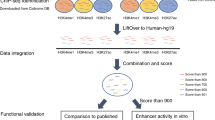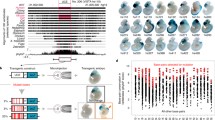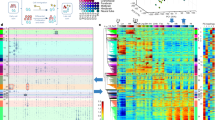Abstract
Accurate control of tissue-specific gene expression plays a pivotal role in heart development, but few cardiac transcriptional enhancers have thus far been identified. Extreme noncoding-sequence conservation has successfully predicted enhancers that are active in many tissues but has failed to identify substantial numbers of heart-specific enhancers. Here, we used ChIP-Seq with the enhancer-associated protein p300 from mouse embryonic day 11.5 heart tissue to identify over 3,000 candidate heart enhancers genome wide. Compared to enhancers active in othertissues we studied at this time point, most candidate heart enhancers were less deeply conserved in vertebrate evolution. Nevertheless, transgenic mouse assays of 130 candidate regions revealed that most function reproducibly as enhancers active in the heart, irrespective of their degree of evolutionary constraint. These results provide evidence for a large population of poorly conserved heart enhancers and suggest that the evolutionary conservation of embryonic enhancers can vary depending on tissue type.
This is a preview of subscription content, access via your institution
Access options
Subscribe to this journal
Receive 12 print issues and online access
$209.00 per year
only $17.42 per issue
Buy this article
- Purchase on Springer Link
- Instant access to full article PDF
Prices may be subject to local taxes which are calculated during checkout




Similar content being viewed by others
References
Hoffman, J.I., Kaplan, S. & Liberthson, R.R. Prevalence of congenital heart disease. Am. Heart J. 147, 425–439 (2004).
Lloyd-Jones, D. et al. Heart disease and stroke statistics–2009 update: a report from the American Heart Association Statistics Committee and Stroke Statistics Subcommittee. Circulation 119, 480–486 (2009).
Pierpont, M.E. et al. Genetic basis for congenital heart defects: current knowledge: a scientific statement from the American Heart Association Congenital Cardiac Defects Committee, Council on Cardiovascular Disease in the Young: endorsed by the American Academy of Pediatrics. Circulation 115, 3015–3038 (2007).
Bruneau, B.G. The developmental genetics of congenital heart disease. Nature 451, 943–948 (2008).
Bentham, J. & Bhattacharya, S. Genetic mechanisms controlling cardiovascular development. Ann. NY Acad. Sci. 1123, 10–19 (2008).
Kleinjan, D.A. & van Heyningen, V. Long-range control of gene expression: emerging mechanisms and disruption in disease. Am. J. Hum. Genet. 76, 8–32 (2005).
Visel, A., Rubin, E.M. & Pennacchio, L.A. Genomic views of distant-acting enhancers. Nature 461, 199–205 (2009).
Aparicio, S. et al. Detecting conserved regulatory elements with the model genome of the Japanese puffer fish, Fugu rubripes. Proc. Natl. Acad. Sci. USA 92, 1684–1688 (1995).
Nobrega, M.A., Ovcharenko, I., Afzal, V. & Rubin, E.M. Scanning human gene deserts for long-range enhancers. Science 302, 413 (2003).
de la Calle-Mustienes, E. et al. A functional survey of the enhancer activity of conserved non-coding sequences from vertebrate Iroquois cluster gene deserts. Genome Res. 15, 1061–1072 (2005).
Woolfe, A. et al. Highly conserved non-coding sequences are associated with vertebrate development. PLoS Biol. 3, e7 (2005).
Prabhakar, S. et al. Close sequence comparisons are sufficient to identify human cis-regulatory elements. Genome Res. 16, 855–863 (2006).
Pennacchio, L.A. et al. In vivo enhancer analysis of human conserved non-coding sequences. Nature 444, 499–502 (2006).
Visel, A. et al. Ultraconservation identifies a small subset of extremely constrained developmental enhancers. Nat. Genet. 40, 158–160 (2008).
Yao, T.P. et al. Gene dosage-dependent embryonic development and proliferation defects in mice lacking the transcriptional integrator p300. Cell 93, 361–372 (1998).
Heintzman, N.D. et al. Distinct and predictive chromatin signatures of transcriptional promoters and enhancers in the human genome. Nat. Genet. 39, 311–318 (2007).
Xi, H. et al. Identification and characterization of cell type-specific and ubiquitous chromatin regulatory structures in the human genome. PLoS Genet. 3, e136 (2007).
Chen, X. et al. Integration of external signaling pathways with the core transcriptional network in embryonic stem cells. Cell 133, 1106–1117 (2008).
Visel, A. et al. ChIP-Seq accurately predicts tissue-specific activity of enhancers. Nature 457, 854–858 (2009).
Valouev, A. et al. Genome-wide analysis of transcription factor binding sites based on ChIP-Seq data. Nat. Methods 5, 829–834 (2008).
Siepel, A. et al. Evolutionarily conserved elements in vertebrate, insect, worm, and yeast genomes. Genome Res. 15, 1034–1050 (2005).
Kuhn, R.M. et al. The UCSC Genome Browser Database: update 2009. Nucleic Acids Res. 37, D755–D761 (2009).
Kothary, R. et al. A transgene containing lacZ inserted into the dystonia locus is expressed in neural tube. Nature 335, 435–437 (1988).
Srivastava, D. Making or breaking the heart: from lineage determination to morphogenesis. Cell 126, 1037–1048 (2006).
Ashburner, M. et al. Gene ontology: tool for the unification of biology. The Gene Ontology Consortium. Nat. Genet. 25, 25–29 (2000).
Schinke, M. Genomics of cardiovascular development, adaptation, and remodeling. (NHLBI Program for Genomic Applications, Harvard Medical School, Boston, Massachusetts, USA, 2009) 〈http://www.cardiogenomics.org〉.
Olson, E.N. Gene regulatory networks in the evolution and development of the heart. Science 313, 1922–1927 (2006).
Cooper, G.M. & Brown, C.D. Qualifying the relationship between sequence conservation and molecular function. Genome Res. 18, 201–205 (2008).
Birney, E. et al. Identification and analysis of functional elements in 1% of the human genome by the ENCODE pilot project. Nature 447, 799–816 (2007).
Margulies, E.H. et al. Analyses of deep mammalian sequence alignments and constraint predictions for 1% of the human genome. Genome Res. 17, 760–774 (2007).
Cheng, Y. et al. Transcriptional enhancement by GATA1-occupied DNA segments is strongly associated with evolutionary constraint on the binding site motif. Genome Res. 18, 1896–1905 (2008).
Heintzman, N.D. et al. Histone modifications at human enhancers reflect global cell-type-specific gene expression. Nature 459, 108–112 (2009).
King, D.C. et al. Finding cis-regulatory elements using comparative genomics: some lessons from ENCODE data. Genome Res. 17, 775–786 (2007).
Fisher, S., Grice, E.A., Vinton, R.M., Bessling, S.L. & McCallion, A.S. Conservation of RET regulatory function from human to zebrafish without sequence similarity. Science 312, 276–279 (2006).
Narlikar, L. et al. Genome-wide discovery of human heart enhancers. Genome Res 20, 381–392 (2010).
Blanchette, M. et al. Aligning multiple genomic sequences with the threaded blockset aligner. Genome Res. 14, 708–715 (2004).
Murphy, W.J., Pringle, T.H., Crider, T.A., Springer, M.S. & Miller, W. Using genomic data to unravel the root of the placental mammal phylogeny. Genome Res. 17, 413–421 (2007).
Bininda-Emonds, O.R. et al. The delayed rise of present-day mammals. Nature 446, 507–512 (2007).
Hedges, S.B. The origin and evolution of model organisms. Nat. Rev. Genet. 3, 838–849 (2002).
Visel, A., Minovitsky, S., Dubchak, I. & Pennacchio, L.A. VISTA Enhancer Browser–a database of tissue-specific human enhancers. Nucleic Acids Res. 35, D88–D92 (2007).
Barrera, L.O. et al. Genome-wide mapping and analysis of active promoters in mouse embryonic stem cells and adult organs. Genome Res. 18, 46–59 (2008).
Li, Z. et al. A global transcriptional regulatory role for c-Myc in Burkitt's lymphoma cells. Proc. Natl. Acad. Sci. USA 100, 8164–8169 (2003).
Blow, M.J. et al. Identification of ancient remains through genomic sequencing. Genome Res. 18, 1347–1353 (2008).
Bryne, J.C. et al. JASPAR, the open access database of transcription factor-binding profiles: new content and tools in the 2008 update. Nucleic Acids Res. 36, D102–D106 (2008).
Bailey, T.L. & Gribskov, M. Combining evidence using P values: application to sequence homology searches. Bioinformatics 14, 48–54 (1998).
Acknowledgements
The authors wish to thank R. Hosseini and S. Phouanenavong for technical support. L.A.P. and E.M.R. were supported by grant HL066681, Berkeley Program for Genomic Applications, which is funded by the National Heart, Lung, and Blood Institute. L.A.P. was also supported by grant HG003988, which is funded by the National Human Genome Research Institute. B.L.B was supported by grants HL64658 and HL89707 from the National Heart, Lung, and Blood Institute. B.R. is supported by funding from the National Human Genome Research Institute and the Ludwig Institute for Cancer Research. Research was conducted at the E.O. Lawrence Berkeley National Laboratory and was performed under the Department of Energy Contract DE-AC02-05CH11231, University of California.
Author information
Authors and Affiliations
Contributions
M.J.B., A.V. and L.A.P. wrote the manuscript. All authors contributed to data collection and analysis and provided comments on the manuscript.
Corresponding authors
Ethics declarations
Competing interests
The authors declare no competing financial interests.
Supplementary information
Supplementary Text and Figures
Supplementary Figures 1–11, Supplementary Tables 5,7,8 and Supplementary Note. (PDF 4563 kb)
Supplementary Tables 1–4
List of p300 peaks from forebrain (XLS 2109 kb)
Supplementary Table 6
Reproducibility of LacZ staining in confirmed positive heart enhancers (XLS 45 kb)
Rights and permissions
About this article
Cite this article
Blow, M., McCulley, D., Li, Z. et al. ChIP-Seq identification of weakly conserved heart enhancers. Nat Genet 42, 806–810 (2010). https://doi.org/10.1038/ng.650
Received:
Accepted:
Published:
Issue Date:
DOI: https://doi.org/10.1038/ng.650
This article is cited by
-
Decoding enhancer complexity with machine learning and high-throughput discovery
Genome Biology (2023)
-
3D genomics and its applications in precision medicine
Cellular & Molecular Biology Letters (2023)
-
Human specificity encoded in the dark matter of the genome
Nature Cardiovascular Research (2022)
-
Genomic enhancers in cardiac development and disease
Nature Reviews Cardiology (2022)
-
Evolution of mouse circadian enhancers from transposable elements
Genome Biology (2021)



